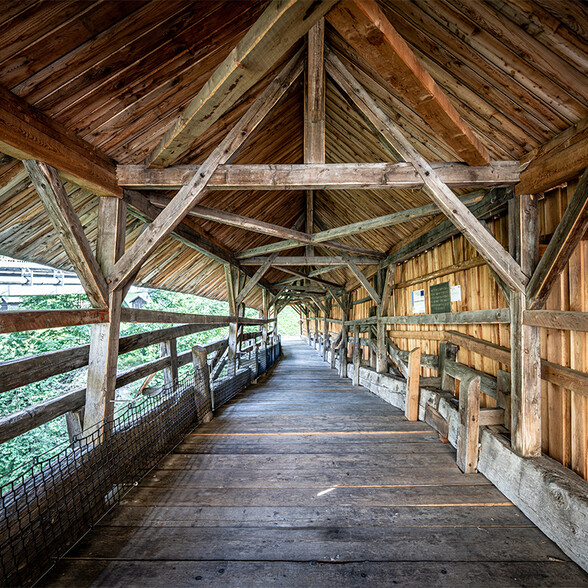
Monument spanning the river
The acid test for a bridge: the covered Rosanna Bridge in Strengen is made entirely of timber. It is the oldest of its kind in Tyrol and a culturally historic gem.
The Rosanna Bridge in Strengen is the ”archetype“ of a bridge: it was built entirely from wood in 1764, without the use of any iron fasteners such as nails, screws or brackets. Only solid craftsmanship held the structure together, until rotten boards and beams made renovations necessary. After roof restorations were carried out in 1975, the bridge was given a general overhaul in 2014 - under strict guidelines, because it has been a listed building since 1972 and was therefore to be restored to its original glory, without the use of metal parts.


This represented a great challenge for the local carpenters and structural engineers, who had to attend a bridge-building seminar to conceive a restoration concept. In addition to the craftsmanship required, the specialists expected dangerous work high above the Rosanna. As the bridge was in danger of sagging on one side, it had to be stabilised on both sides with concrete pillars. The bridge builders of the 18th century also achieved great things. Procuring the timber alone was quite a feat at that time. The tree trunks of up to 10-metres long had to be drifted down to the valley on snow from Dawinalm Farm. As too little snow fell for two consecutive winters, construction of the bridge was delayed. But the time eventually came, and the engineers could set to work.
The 38-metre-long Rosanna Bridge with an 18-metre span was constructed as a single-lane, combined beam and suspension bridge, with a gable roof and cladding on the weather side. Initially, it served to provide access to the south-facing farmlands and forest plots. At that time, the main village of Strengen consisted of only a few houses and it was mostly waggons and sledges that bumped over the bridge. With construction of the Arlberg railway in 1884, the bridge gained new importance. Workers who were housed in Strengen and all the inhabitants who wanted to get to the railway station on the other side, had to cross the bridge. The narrow bridge with its steep, almost right-angled approach was problematic for car traffic. Off-road vehicles were best able to negotiate it, but their occupants often had a queasy feeling as they bumped along the rickety planks. A new bridge was built down river in 1963. Since then, the culturally historic gem has been insignificant from a traffic perspective, but it still fulfils its function as a pedestrian bridge. If you keep your eyes peeled when crossing the bridge, you will discover written insignias, where the bridge builders carved their initials into the wood in 1764.
